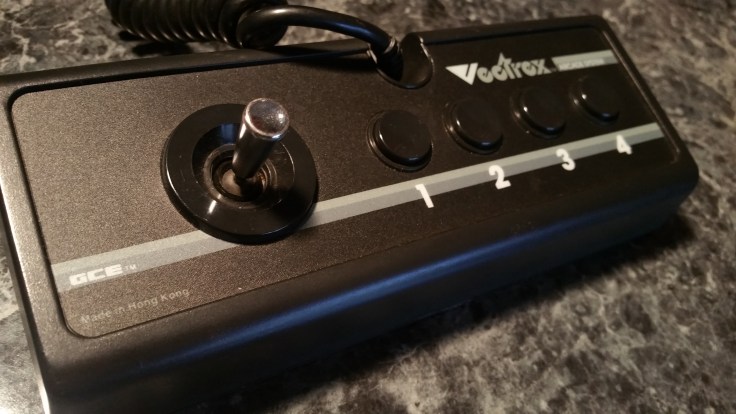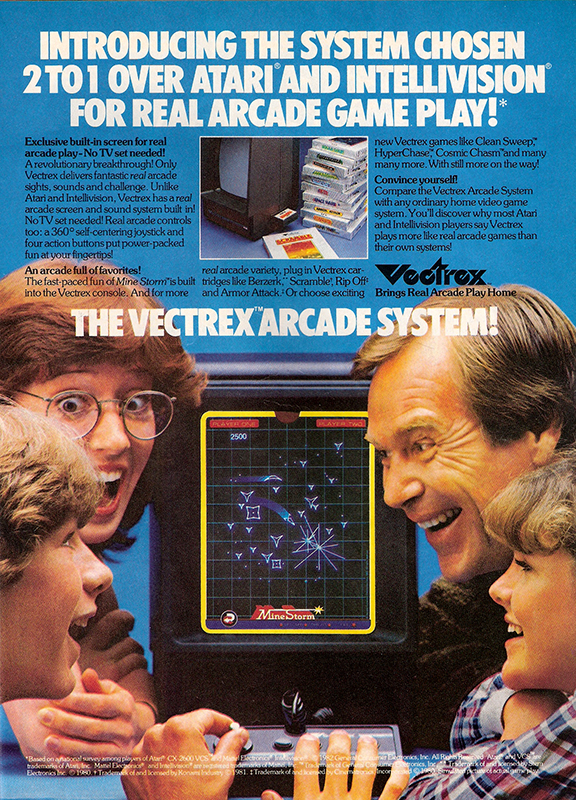
We all love the Atari 2600 and the Famicom and the Neo-Geo and yadda yadda yadda yeah yeah sure fine whatever. But seriously, has any console ever been as outright COOL as the Vectrex?
(The correct answer is “no.”)
Released in 1982 by GCE, the Vectrex was a self-contained videogame console built around a 9″ vector monitor.
Read that again: we’re not talking a Nintendo 3DSXL with two color LCD screens that was made last year. We’re talking 1982 — 35 years ago — and you got your own goddam vector monitor with this system.
The Vectrex was a sleek, black, all-in-one unit, approximately 80% of which was monitor (with a cartridge slot on the right side), and the other 20% being a wired controller which could attach at the bottom front of the machine and flip up for storage with a super clean look. Behind the controller is the power/volume knob and a reset button. There’s a cutout at the top back of the unit for easy carrying, essenstially making it a portable game system.
The controller is a small, metal, self-centering analog joystick with four buttons — a similar layout to Neo-Geo, but again, two generations earlier. It’s meant to sit on a table rather than held in the hands, adding to the arcade feel.

The black and white vector (or X/Y) monitor provided arcade-quality graphics, much like you’d see in arcade games like Asteroids/Asteroids Deluxe, Star Castle, Tempest, Quantum, and Star Wars, with ultra-fluid movement and animation. Vector graphics also allowed for perfectly smooth scaling and rotation, years before the Super Famicom/SNES’ Mode 7 hit the scene.
To compensate for the lack of color, the Vectrex’s cartridges came with colored plastic overlays, with a custom design for each game. Much like the early arcade games that used colored gel overlays to simulate color on their B&W monitors, the Vec’s overlays gave everything a cool colored glow and also were printed with the game’s logo, a graphic border, and button functions at the bottom. This gave the console a real arcade feel with each game you played.
The Vectrex has one game, MineStorm, built-in, so you’re ready to play before you even buy any cartridges. MineStorm is sort of a take-off on Asteroids, wherein you fly a spaceship around the screen and mines pop up. As you shoot the larger mines, smaller mines take their place, until the screen is cleared and a new round begins. It’s just as fun as Asteroids, if not more so, as it offers new wrinkles to the game concept and can keep a player busy for hours. Mine Storm had a glitch on level 13 which could crash the game, and if players called to report it, they were sent a free MineStorm II cartridge!

Beyond that, 29 officially-released games made up the Vectrex library, which included both licensed arcade titles and original games.
Some of the licensed titles, such as Berzerk and Pole Position, were interesting because the arcade originals were raster games, rather than vector. So it’s cool to see how they interpret these into a vector graphic environment (the answer is very well, with both games being very fun and playable, with Pole Position especially notable since the scaling on the cars is actually smoother than the original arcade version). Star Castle, which is a vector-based arcade classic by Cinematronics (and a personal favorite of mine), gets a nearly arcade-perfect port, down to the colored overlay included with the cartridge that mimics that of the coin-op. In fact, many of Cinematronics’ vector arcade games, such as Rip-Off, Cosmic Chasm, and Armor Attack, came home to the Vectrex in beautiful ports not possible on other home consoles.
The original Vec games were just as good, my own favorite being Fortress of Narzod, a variation on the Galaga/Satan’s Hollow-type theme which puts your shooter ship in a narrow, crooked valley leading up a mountain, allowing your shots to ricochet off the walls and into the advancing enemies (but also back into you, if you’re not careful!).

And then there were the accessories — 3D glasses (with certain games made for use with them) and a light pen, which turned the Vectrex into an even more immersive and creative machine.
Did I mention this was way back in nineteen eighty-frickin-two? I did? Okay, just wanted you to keep that in mind.
Unfortunately, due to the crash of the home videogame market just a short time after the Vectrex went on sale, the system never got real widespread marketing and didn’t get the shot it should have.

I remember the Vectrex being out in the early ’80s, having seen it advertised in magazines such as Electronic Games, but never actually saw them on sale anywhere around me. I didn’t obtain one of my own until around 1999 or 2000, at a videogame shop in Madison, Wisconsin, which I got for $150 — a steal at today’s prices, which run into the multiple hundreds for a working unit. I immediately ordered a Vectrex multi-cart from well-known Vec fan and hobbyist Sean Kelly (a well-known figure back in the RGVC days), and instantly had the entire Vectrex library at my disposal. Unfortunately, I still don’t own any original cartridges, which means I only have one overlay — Mine Storm, of course — so I’m not really getting the “full-color” experience (which is why all my screenshots are blue, sorry). I’d consider myself semi-in-the-market for some of my favorites though, particularly Star Castle. Occasionally, loose overlays do pop up, and there are repros available as well, so I may go that route too.
What a brilliant game console, and an amazing piece of disruptive technology. While Atari and Coleco were trying to beat each other in the TV game race, Vectrex came along and gave home gamers a truly high-end, arcade-like experience, at the same cost as the others — and out-cooled them all.




Leave a comment